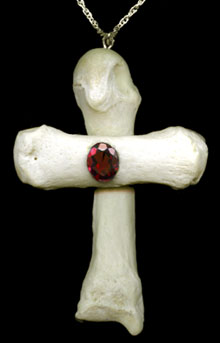A necklace of phalanges costs $165 and a cross of metacarpal goes for $80 on Columbine Phoenix’s website.

A necklace with a cross made out of human metacarpal bones goes for $80 on “The Churchyard”, an online jewelry shop run by Columbine Phoenix. (Photo courtesy of Columbine Phoenix)
The retail jeweler sells agate chalices, crystal wands, and ceremonial blades, but her favorite merchandise is the necklaces and earrings made of human bone that she crafts herself. Chain necklaces, strung with a single human molar, are also available.
“This is something solid that you can hold in your hand or wear in your ear,” said Phoenix. “It makes death a little less scary.”
The bones come from an education supply store, the same place she gets her rat and bat skulls. The supply store obtains the human bones from retired science classroom skeletons.
“You can tell that they were from a good family,” said Phoenix, referring to the skeletons. “They got their milk, and they’re strong.”
Bones don’t come cheaply, though. A hand goes for about $250, she said, and a whole skeleton costs more like $5,000. Skulls alone cost about $1,000 and are purchased in large numbers by art schools. “Supposedly, you can’t draw a human face until you can draw a skull,” said Phoenix.
Crafting bone jewelry is actually quite difficult. “The strength of bone is all on the outside,” she explained. “The inside is honeycombed and light, or else it would be too heavy to walk.”
Hand bones are the best to work with, others being too clunky. When Phoenix pierces a bone with a pin, she smothers the hole with glue to lessen the risk of a fracture.
Teen metalheads and Goths, with a penchant for the occult and death, represent a large customer base, but middle-aged professionals buy bone jewelry, too, especially doctors and dentists. “They like it for the same reason I do,” said Phoenix, “because humans are an engineering miracle.”
One of the more interesting special requests came from a soldier who wanted a bone necklace. “Nothing fancy or pretty,” said Phoenix, “just to scare bad guys.”
A woman whose ankle had been smashed in a car accident wanted a necklace with an ankle bone. Etched in the bone, she requested a rune—an ancient alphabet symbol—that depicted healing and was studded on the bones. She wanted stones of hematite and aventurine, a type of quartz that can be green, blue, brown, or pink and is said to attract wealth. “The insurance company was fighting her tooth and nail,” Phoenix said. “She won her court case, and she is now walking without a cane.”
Using bones for jewelry is perfectly legal as long as the bones come from within the United States. Phoenix is suspect of bones that seem too cheap. These could have been robbed from graves in third-world countries, she said. On eBay, a recent search for “real human skulls” returned 12 hits, with items selling from $103.50 to $1,000.
There is a precedent to using human bone to craft fine art objects. A Tibetan trumpet called a kangling is often made from a human femur. The instrument is played in a ritual of self-sacrifice known as Chod, in which a person trying to discard the ego and achieve fearlessness imagines their body as an offering in a tantric feast.
Kutna hora is a haunting church a day’s drive from the city of Prague, in the Czech Republic, with fixtures and ornaments made entirely of human bone. Femurs dangle from a towering ceiling, and one particularly delicate chandelier consists of every bone in the human body. The church’s history explains the story.
During the Middle Ages, a handful of soil from the Holy Land was sprinkled over the surrounding graveyard, which made the spot a popular burial site. Eventually, the grounds ran out of space, and older bones were dug up and stored in the chapel’s crypt. In 1870, a woodcarver named Frantisek Rint was commissioned to decorate the chapel. Although legend has it that monks went mad and assembled the bones, they are actually the work of Rint.
Kutna hora has become a must-see for travelers interested in the supernatural, but Phoenix says her interests are more down-to-earth. “I do it because I love it,” she said, “and nobody else would really be able to do it well.”










Scully
I guess this gives new meaning to things “Hand Made” on the Esty site too.
Interesting.